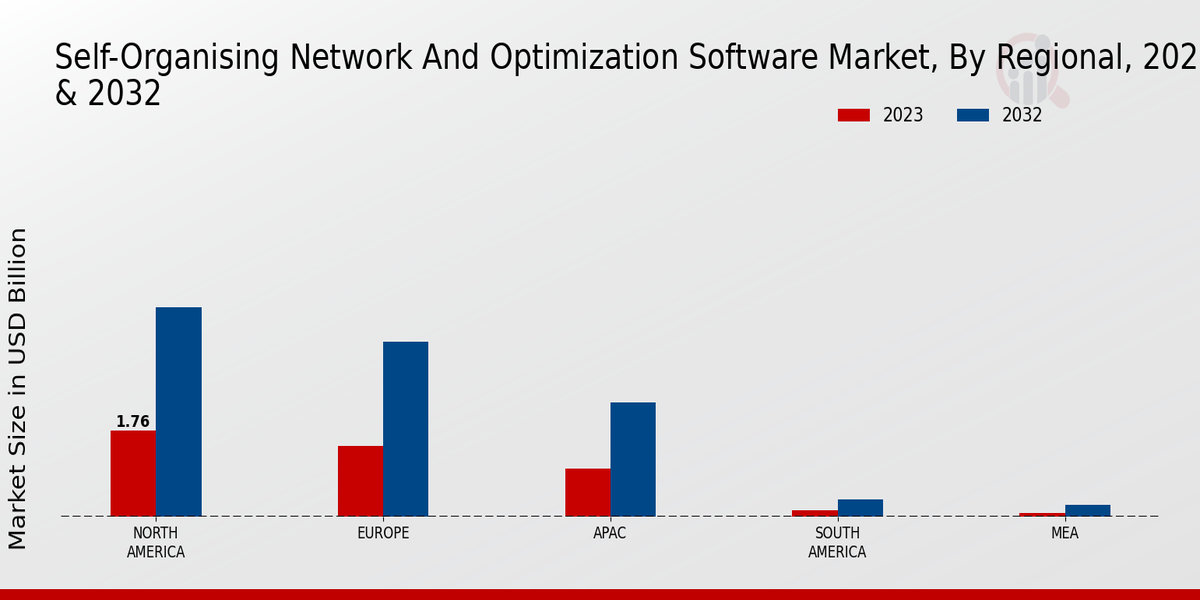Emergence of IoT Devices
The proliferation of Internet of Things (IoT) devices is significantly impacting the Self Organising Network and Optimization Software Market. As the number of connected devices continues to rise, the complexity of managing these networks increases correspondingly. Self-organizing network solutions are essential for efficiently handling the vast amounts of data generated by IoT devices, ensuring optimal performance and reliability. Market projections indicate that the IoT sector will surpass 1 trillion dollars by 2025, creating substantial demand for optimization software that can seamlessly integrate with these devices. This trend highlights the necessity for self-organizing technologies that can adapt to the unique challenges posed by IoT environments, thereby driving innovation and growth within the Self Organising Network and Optimization Software Market.
Adoption of 5G Technology
The advent of 5G technology is poised to revolutionize the Self Organising Network and Optimization Software Market. With its promise of ultra-fast data speeds and low latency, 5G is creating new opportunities for self-organizing networks to thrive. As telecommunications companies roll out 5G infrastructure, the demand for optimization software that can efficiently manage the increased complexity of these networks is escalating. Industry forecasts suggest that the 5G market will reach a valuation of over 700 billion dollars by 2026, driving significant investments in self-organizing technologies. This shift not only enhances user experiences but also necessitates the development of sophisticated optimization solutions that can adapt to the dynamic nature of 5G networks, thereby propelling growth in the Self Organising Network and Optimization Software Market.
Increased Focus on Network Security
In the current landscape, the Self Organising Network and Optimization Software Market is witnessing an increased emphasis on network security. As cyber threats become more sophisticated, organizations are compelled to adopt advanced software solutions that can autonomously detect and mitigate potential vulnerabilities. The integration of self-organizing networks with robust security protocols is becoming a critical requirement for businesses aiming to safeguard their data and maintain operational integrity. Market analysis indicates that investments in network security solutions are expected to rise significantly, with a projected increase of over 20% in the next few years. This trend underscores the importance of self-organizing network technologies that not only optimize performance but also enhance security measures, thereby driving growth within the Self Organising Network and Optimization Software Market.
Rising Demand for Network Efficiency
The Self Organising Network and Optimization Software Market is experiencing a notable surge in demand for enhanced network efficiency. As organizations increasingly rely on complex network infrastructures, the need for software that can autonomously manage and optimize these networks becomes paramount. According to recent data, the market for network optimization solutions is projected to grow at a compound annual growth rate of approximately 15% over the next five years. This growth is driven by the necessity for reduced operational costs and improved service quality, compelling businesses to adopt self-organizing technologies that streamline network management processes. Consequently, the Self Organising Network and Optimization Software Market is positioned to benefit from this trend, as companies seek solutions that not only enhance performance but also ensure scalability and adaptability in an ever-evolving technological landscape.
Growing Need for Real-Time Data Analytics
The Self Organising Network and Optimization Software Market is increasingly influenced by the growing need for real-time data analytics. Organizations are recognizing the value of leveraging data to make informed decisions regarding network performance and optimization. Self-organizing network solutions that incorporate real-time analytics capabilities enable businesses to monitor network conditions, identify issues, and implement corrective actions swiftly. This trend is reflected in market data, which indicates that the demand for analytics-driven optimization software is expected to grow by approximately 18% annually. As companies strive for operational excellence and enhanced customer experiences, the integration of real-time analytics into self-organizing networks is becoming a critical driver of growth within the Self Organising Network and Optimization Software Market.












Leave a Comment